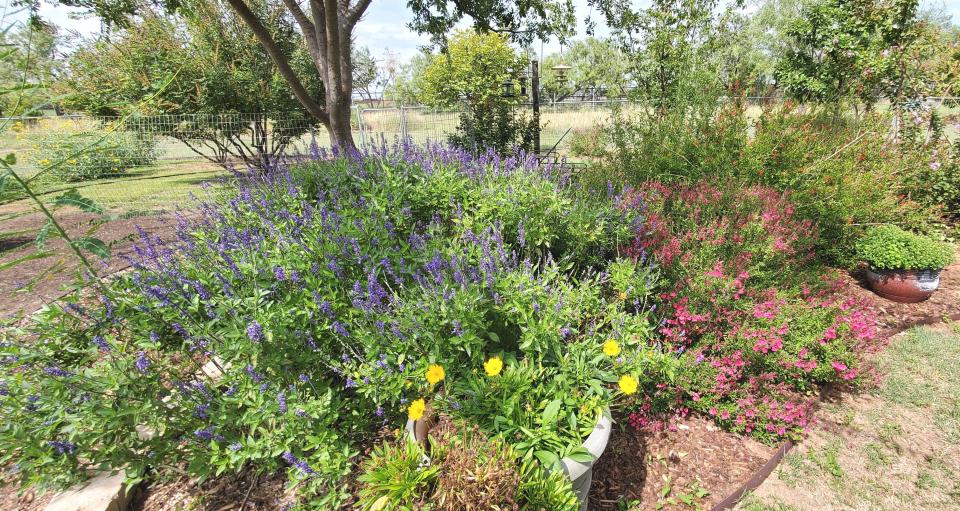You will fall for salvia, and its many varieties
A while back, I was thinking about putting together something on salvias.
It's one of my favorite garden plants. My plan was to put together something big, comprehensive, talk about ALL the different salvias. Yep, that sounded good. So, I started my research.
Hmmm, maybe I bit off a little more than I can chew. '

Three thousand species, huh? Not including hybrids. Twenty or so in Texas alone. Well, I guess I need to re-evaluate my plan. How about some information on some of my favorite salvias.
Salvia greggi
Salvia greggi is more commonly called autumn sage. It’s a great Texas native and probably the salvia most folks are familiar with. Originally, it was called cherry sage because the flowers were bright red. But now it comes in pretty much every color of the rainbow, except true blue.
It’s tough and beautiful. Butterflies and bumblebees like it, hummingbirds love it. Autumn sage also has that great combination of somewhat fuzzy foliage and strong scent that make it less popular with deer and rabbits. I’m not saying they won’t eat it, but it’s usually one of their last choices.
Salvia greggii is a perennial. Most folks shear it back a little after its spring bloom, to deadhead it for its second round of flowers in the fall. It can get a little woody so cut it back by about a third in late winter. In mild winters it may keep most of its leaves and put out an occasional flower.
During the big freeze of ’21, mine died back to the ground, but came back in the spring looking like new. I guess that what does not kill you really does make you stronger. I do get occasional spider mites. I use soapy water on the leaves and stems, that usually takes care of it.
Salvia nemorosa
Saliva nemorosa, also called woodland or meadow sage, is an Old-World salvia, but pretty durable and a great pollinator plant. Also a perennial, but smaller, less shrubby than greggii. It has a rosette of leaves and the flower spikes come out from that. The most common color is deep blue or purple, but there’s also white and a new rose color that is really pretty.
For me, it’s one of the first plants to bloom in spring and bees love it. I usually try to garden with natives, but I make an exception for this plant. This one reseeds, but not too aggressively, so I usually have a few to share.
Salvia farinacea
Salvia farinacea or mealy cup sage is a mounding plant with gray green leaves and blue or white flower spikes. This is a good size plant; 2 to 3 ft. tall. They die back in the winter, but come back in the spring. Like the other salvias, they are loved by pollinators, not so much by deer. Prune it back a little after an extended bloom to keep it from flopping. There are a couple of cultivars that are particularly popular.
Victoria blue is commonly found locally. It’s a beautiful deep blue. Henry Duelberg is a Texas Superstar. That means it’s low maintenance and heat tolerant. August Duelberg is a white variety and though its not a Texas Superstar, I find Augusta to be just as durable as her husband, Henry. One of these days I’ll tell you the story of Henry and Augusta.
Salvia coccinea
Salvia coccinea is also called tropical salvia. Its an annual, but readily re-seeds. Red and pink are the most common colors. I use it in flowers pots, though I will always find a few growing in the garden from seeds that ended up there. They will cross pollinate, so they don’t always come true from their seed. Another pollinator favorite. '
This is just the tip of the iceberg, but for tough conditions and a good pollinator plant, its pretty hard to beat salvias. Be sure to check them out at the BCMG Plant Sale in October, we always have a great selection of salvias. We hope that you will like our Facebook page at https://www.facebook.com/bigcountrymastergardeners and the Texas Viticulture and Enology’s Facebook Page at https://www.facebook.com/TXViticulture/.
Go to Big Country Master Gardeners at www.bcmgtx.org for information and future events.
This article originally appeared on Abilene Reporter-News: You will fall for salvia, and its many varieties

